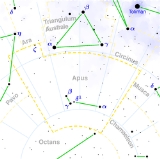
Iota Apodis
Encyclopedia
Iota Apodis is a double
or multiple star system in the constellation
Apus
. It is approximately 1140 light years
from Earth
. The double star is composed of two blue-white B-type
main sequence dwarfs
with apparent magnitude
s of +5.9 and +6.4. The stars are separated by 0.121 arcseconds on the sky. The combined apparent magnitude of the system is +5.39.
Double star
In observational astronomy, a double star is a pair of stars that appear close to each other in the sky as seen from Earth when viewed through an optical telescope. This can happen either because the pair forms a binary star, i.e...
or multiple star system in the constellation
Constellation
In modern astronomy, a constellation is an internationally defined area of the celestial sphere. These areas are grouped around asterisms, patterns formed by prominent stars within apparent proximity to one another on Earth's night sky....
Apus
Apus
Apus is a faint constellation in the southern sky, first defined in the late 16th century. Its name means "no feet" in Greek, and it represents a bird-of-paradise . It is bordered by Triangulum Australe, Circinus, Musca, Chamaeleon, Octans, Pavo and Ara...
. It is approximately 1140 light years
Light Years
Light Years is the seventh studio album by Australian recording artist Kylie Minogue. It was released on 25 September 2000 by Parlophone and Mushroom Records. The album's style was indicative of her return to "mainstream pop dance tunes"....
from Earth
Earth
Earth is the third planet from the Sun, and the densest and fifth-largest of the eight planets in the Solar System. It is also the largest of the Solar System's four terrestrial planets...
. The double star is composed of two blue-white B-type
Stellar classification
In astronomy, stellar classification is a classification of stars based on their spectral characteristics. The spectral class of a star is a designated class of a star describing the ionization of its chromosphere, what atomic excitations are most prominent in the light, giving an objective measure...
main sequence dwarfs
Main sequence
The main sequence is a continuous and distinctive band of stars that appears on plots of stellar color versus brightness. These color-magnitude plots are known as Hertzsprung–Russell diagrams after their co-developers, Ejnar Hertzsprung and Henry Norris Russell...
with apparent magnitude
Apparent magnitude
The apparent magnitude of a celestial body is a measure of its brightness as seen by an observer on Earth, adjusted to the value it would have in the absence of the atmosphere...
s of +5.9 and +6.4. The stars are separated by 0.121 arcseconds on the sky. The combined apparent magnitude of the system is +5.39.

